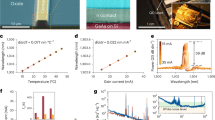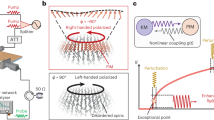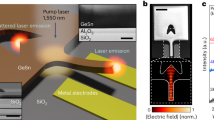Abstract
A two-level atom cannot emit more than one photon at a time. As early as the 1980s, this quantum feature was identified as a gateway to ‘single-photon sources’, where a regular excitation sequence would create a stream of light particles with photon number fluctuations below the shot noise1. Such an intensity-squeezed beam of light would be desirable for a range of applications, such as quantum imaging, sensing, enhanced precision measurements and information processing2,3. However, experimental realizations of these sources have been hindered by large losses caused by low photon-collection efficiencies and photophysical shortcomings. By using a planar metallodielectric antenna applied to an organic molecule, we demonstrate the most regular stream of single photons reported to date. The measured intensity fluctuations were limited by our detection efficiency and amounted to 2.2 dB squeezing.
This is a preview of subscription content, access via your institution
Access options
Subscribe to this journal
Receive 12 print issues and online access
$209.00 per year
only $17.42 per issue
Buy this article
- Purchase on Springer Link
- Instant access to full article PDF
Prices may be subject to local taxes which are calculated during checkout



Similar content being viewed by others
References
Mandel, L. Sub-Poissonian photon statistics in resonance fluorescence. Opt. Lett. 4, 205–207 (1979).
Lounis, B. & Orrit, M. Single-photon sources. Rep. Prog. Phys. 68, 1129–1179 (2005).
Polyakov, S. V. & Migdall, A. L. Quantum radiometry. J. Mod. Opt. 56, 1045–1052 (2009).
Kimble, H. J., Dagenais, M. & Mandel, L. Photon antibunching in resonance fluorescence. Phys. Rev. Lett. 39, 691–694 (1977).
Teich, M. C. & Saleh, B. E. A. Photon bunching and antibunching. Prog. Opt. 26, 1–104 (1988).
Kwiat, P. G., Mattle, K., Weinfurter, H. & Zeilinger, A. New high-intensity source of polarization-entangled photon pairs. Phys. Rev. Lett. 75, 4337–4341 (1995).
Gisin, N., Ribordy, G., Tittel, W. & Zbinden, H. Quantum cryptography. Rev. Mod. Phys. 74, 145–195 (2002).
Mohtashami, A. & Koenderink, A. F. Suitability of nanodiamond nitrogen-vacancy centers for spontaneous emission control experiments. New J. Phys. 15, 043017 (2013).
Kuno, M., Fromm, D. P., Hamann, H. F., Gallagher, A. & Nesbitt, D. J. ‘On’/‘off’ fluorescence intermittency of single semiconductor quantum dots. New J. Phys. 115, 1028–1040 (2001).
Chen, X.-W., Götzinger, S. & Sandoghdar, V. 99% efficiency in collecting photons from a single emitter. Opt. Lett. 36, 3545–3547 (2011).
Chu, X.-L. et al. Experimental realization of an optical antenna designed for collecting 99% of photons from a quantum emitter. Optica 1, 203–208 (2014).
Lee, K.-G. et al. A planar dielectric antenna for directional single-photon emission and near-unity collection efficiency. Nat. Photon. 5, 166–169 (2011).
Pfab, R. J. et al. Aligned terrylene molecules in a spin-coated ultrathin crystalline film of p-terphenyl. Chem. Phys. Lett. 387, 490–495 (2004).
Treussart, F. et al. Direct measurement of the photon statistics of a triggered single photon source. Phys. Rev. Lett. 89, 093601 (2002).
Buchler, B. C., Kalkbrenner, T., Hettich, C. & Sandoghdar, V. Measuring the quantum efficiency of the optical emission of single radiating dipoles using a scanning mirror. Phys. Rev. Lett. 95, 063003 (2005).
Fox, M. Quantum Optics: An Introduction (Oxford Univ. Press, 2006).
Lounis, B. & Moerner, W. E. Single photons on demand from a single molecule at room temperature. Nature 407, 491–493 (2000).
Knill, E., Laflamme, R. & Milburn, G. J. A scheme for efficient quantum computation with linear optics. Nature 409, 46–52 (2001).
Lettow, R. et al. Quantum interference of tunably indistinguishable photons from remote organic molecules. Phys. Rev. Lett. 104, 123605 (2010).
Kuhn, A., Hennrich, M. & Rempe, G. Deterministic single-photon source for distributed quantum networking. Phys. Rev. Lett. 89, 067901 (2002).
McKeever, J. et al. Deterministic generation of single photons from one atom trapped in a cavity. Science 303, 1992–1994 (2004).
Basché, T., Moerner, W. E., Orrit, M. & Talon, H. Photon antibunching in the fluorescence of a single dye molecule trapped in a solid. Phys. Rev. Lett. 69, 1516–1519 (1992).
Lounis, B., Jelezko, F. & Orrit, M. Single molecules driven by strong resonant fields: hyper-Raman and subharmonic resonances. Phys. Rev. Lett. 78, 3673–3676 (1997).
Imamoglu, A. & Yamamoto, Y. Turnstile device for heralded single photons: coulomb blockade of electron and hole tunneling in quantum confined p-i-n heterojunctions. Phys. Rev. Lett. 72, 210–213 (1994).
Kim, J., Benson, O., Kan, H. & Yamamoto, Y. A single-photon turnstile device. Phys. Rev. Lett. 397, 500–503 (1999).
Kurtsiefer, C., Mayer, S., Zarda, P. & Weinfurter, H. Stable solid-state source of single photons. Phys. Rev. Lett. 85, 290–293 (2000).
Diedrich, F. & Walther, H. Nonclassical radiation of a single stored ion. Phys. Rev. Lett. 58, 203–206 (1987).
Keller, M., Lange, B., Hayasaka, K., Lange, W. & Walther, H. Continuous generation of single photons with controlled waveform in an ion-trap cavity system. Nature 431, 1075–1078 (2004).
Kolesov, R. et al. Optical detection of a single rare-earth ion in a crystal. Nat. Commun. 3, 1029 (2012).
Eichhammer, E., Utikal, T., Götzinger, S. & Sandoghdar, V. High-resolution spectroscopy of single Pr3+ ions on the 3H4–1D2 transition. New J. Phys. 17, 083018 (2015).
Strauf, S. et al. High-frequency single-photon source with polarization control. Nat. Photon. 1, 704–708 (2007).
Michler, P. et al. A quantum dot single-photon turnstile device. Science 290, 2282–2285 (2000).
Liebermeister, L. et al. Tapered fiber coupling of single photons emitted by a deterministically positioned single nitrogen vacancy center. Appl. Phys. Lett. 104, 031101 (2014).
Claudon, J. et al. A highly efficient single-photon source based on a quantum dot in a photonic nanowire. Nat. Photon. 4, 174–177 (2010).
Arcari, M. et al. Near-unity coupling efficiency of a quantum emitter to a photonic crystal waveguide. Phys. Rev. Lett. 113, 093603 (2014).
Aharonovich, I., Englund, D. & Toth, M. Solid-state single-photon emitters. Nat. Photon. 10, 631–641 (2016).
Cheung, J. Y. et al. The quantum candela: a re-definition of the standard units for optical radiation. J. Mod. Opt. 54, 373–396 (2007).
Scarani, V. et al. The security of practical quantum key distribution. Rev. Mod. Phys. 81, 1301–1350 (2009).
Waks, E., Santori, C. & Yamamoto, Y. Security aspects of quantum key distribution with sub-Poisson light. Phys. Rev. A 66, 042315 (2002).
Labroille, G. et al. Efficient and mode selective spatial mode multiplexer based on multi-plane light conversion. Opt. Express 22, 518–519 (2014).
Acknowledgements
We thank X.-W. Chen for help with the antenna design and simulation. This project was supported by the European Union (European Research Council Advanced Grant SINGLEION) and the SIQUTE (single photon sources for quantum technologies) project of the European Metrology Research Program, an Alexander von Humboldt professorship and the Max Planck Society.
Author information
Authors and Affiliations
Contributions
S.G. and V.S. conceived and supervised the project. X.-L.C. performed the experiments and analysed the data. All the authors prepared the manuscript.
Corresponding authors
Ethics declarations
Competing interests
The authors declare no competing financial interests.
Rights and permissions
About this article
Cite this article
Chu, XL., Götzinger, S. & Sandoghdar, V. A single molecule as a high-fidelity photon gun for producing intensity-squeezed light. Nature Photon 11, 58–62 (2017). https://doi.org/10.1038/nphoton.2016.236
Received:
Accepted:
Published:
Issue Date:
DOI: https://doi.org/10.1038/nphoton.2016.236
This article is cited by
-
An optofluidic antenna for enhancing the sensitivity of single-emitter measurements
Nature Communications (2024)
-
Dissipative dynamics of optomagnonic nonclassical features via anti-Stokes optical pulses: squeezing, blockade, anti-correlation, and entanglement
Scientific Reports (2023)
-
Applications of single photons to quantum communication and computing
Nature Reviews Physics (2023)
-
Quantum NETwork: from theory to practice
Science China Information Sciences (2023)
-
Spatio-Temporal Correlations of Photons from a Pseudo-Thermal Source
Journal of Applied Spectroscopy (2023)



